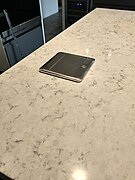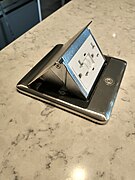Kitchen Remodel/Utility connections and lighting
|
Heating and ventilation[edit | edit source]

Heating, heating radiators and hot air registers are definitely elements that need to be carefully incorporated when a new kitchen is planned. But since I don't know the first thing about it and there is plenty of information on the internet, I will omit this subject here.
Only so much: if you have baseboard heaters and one of those happens to be in the way of a new row of cabinets that you are planning, there will probably be the alternative option of a toe-space or kick-space heater. We had one installed with our first kitchen remodel and found the performance quite convincing.
Another important topic that I have to omit in this book is ventilation. In my own kitchen remodel project, we moved the range, and with it the exhaust hood, to a whole different place within the room. Our craftsman took care of everything, capped the old duct and installed a new one directly through the roof.
Water connections[edit | edit source]
If the dry wall is down anyway, it will usually be no problem to modify the water connections, if the new kitchen layout requires any changes.
In my own project, we had plumbing work done to upgrade the fresh water and wastewater connections for sink and dishwasher. We also needed an additional cold water line for the ice maker in our refrigerator. The thin hose which connects both ends was fed through the ceiling. It has its own little filter system that sits under the sink.
Another modification that we did to our water supply system in general was the addition of a hot water recirculation system. Before we had that system, we had the problem that our water heater stands in the garage and hence far away from all faucets. The recirculation system provides us with a much quicker onset of hot water coming out of the faucets, so there is less water wasted. By the way, in spite of our craftsman knitting his brows, we decided to run the system on the "on demand" setting which works very fine for us.
Electrical connections[edit | edit source]

I will not write about natural gas here, since we decided to have photovoltaic on the roof and get rid of gas altogether. I don't know anything about it.
As to the topic of electrical connections: Electricians are experts for electrical connections and know how to map out the electrical installations for a kitchen. The probably most important input that the customer can contribute is to point out where they want electrical outlets, and how many. Prime locations for outlets are obviously the places where your appliances sit (if they are not hardwired), the wall areas directly above countertops and all the places where an occasionally used appliance like a vacuum cleaner would be plugged in. In some cases, it may be even convenient, to have an outlet in a cabinet, for example if this is where you want to run a clunky kitchen device, like a bread slicer, or a computer printer that didn't find a better place in your home.
Since in our kitchen there are two rather long peninsulas, we decided to electrify those, too. One of the peninsula outlets is a pop-up outlet on the top of a countertop and the other is a regular outlet underneath the bar overhang. As for the pop-up outlet, we selected the smallest we could get. Most of them, similar to icebergs, feature a below-the-countertop apparatus that is huge. I figured we would not be willing to sacrifice a lot of the cabinet space, but only as little as possible.
-
My pop-out outlet, closed
-
The same, opened
-
The same, as seen from within the cabinet
-
The outlet under my (not finished) bar
Another gizmo that we decided to have in our kitchen was one special back-up circuit that we can feed from an external source, if needed, that is in power outages. The battery of our electric vehicle is the source; the technology is called "vehicle-to-load". We figured that this would be much cheaper than a house battery (plus you have a car). The circuit includes the outlet for the refrigerator, some of the kitchen lighting, our house electronics and one outlet that we can use to charge our phones.
Lighting[edit | edit source]
"Lighting" includes in a kitchen, as in any other room…
- mapping of one ore more lighting systems
- mapping of wiring and of light controls
- product selection
Relevant web sites commonly distinguish between general lighting, work lighting and accent lighting. This may be helpful or not. I personally believe that under many circumstances, a lighting system can provide both general lighting and work lighting. If it is dimmable, it can even be an accent lighting, too. But still I would prefer to have a composite lighting scheme. The reason is that this will allow to set the light – and thereby also staging the kitchen – in a number of different ways. If you put a lot of effort into designing a beautiful space, you will also want to show it off properly and congenially.

For my kitchen space, I chose no less than six different lighting systems, five of which are dimmable:
-
1. recessed lights (main space), 2. range hood light
-
3. soffit track lighting, 4. floating shelves with integrated light
-
5. pendant light (breakfast area)
-
6. recessed lights (pantry)
- As our principal lighting, I chose an L-shaped array of recessed lights. Those are aligned with two legs of our J-shaped group of base cabinets in a way that they light the countertop. The general question for any modern recessed light is if you want to install it in a new construction can or if you rather want to use remodel lights. The latter are cheaper, but electricians seem to hate them because they are more cumbersome to install. Since our ceiling dry wall was down anyway, new construction cans would have been the sensible choice for us, but we still used remodel lights because we had bought those early, still in blessed ignorance of the difference. (Saved us money.)
- Since the main kitchen space can be entered from two directions (from the pantry/hallway and from the living room), we needed three-way circuits for all our lighting in this space, with controls at both entrance points.
- Our new range hood came with a glorious array of four strong LED lights. I a raving about it because our old microwave oven/range hood combination that we had put in operation with our first kitchen remodel, almost a decade ago, gave only dim light, which left us half blind when cooking food. That was an untenable situation.

- My secondary lighting is a track lighting system that is installed on the soffit which separates kitchen and living space. The existence of this soffit is the (now revered) result of my ignorance of soffit anatomy (in European living spaces, there occur virtually no soffits). After studying that soffit from the living room side, I hadn't expected that it would be part of the demolition. Instead, I had pictured that our construction workers would simply open the wall below and keep the soffit untouched. I was wrong there. The standard procedure for our carpenters was to dismantle the existing soffit and to rebuild it pretty much from scratch.
- But I had embraced the idea of a soffit from the beginning, for multiple reasons. First, it would complement the suspended ceiling in the pantry/hallway. Secondly, it would help to define the transition between kitchen and living space. And thirdly, it would carry a wall mounted lighting system for the second one of my peninsulas.
- Since we don't have wall cabinets, I figured that there would be room for two floating wall shelves. Those are available with integrated LED lighting. Our electrician provided us with the required low voltage installation.
- For the breakfast nook in the northernmost part of the space, we decided on a pendant light. The controls are located at the two entrance points of that space.
- The pantry features another array of recessed lights. Again, we used remodel lights, but in this case for the reason that this ceiling holds the ducts of our forced air heating and therefore didn't leave enough room for new construction cans. The controls are located at the two entry points of this space.
Three remarks about controls:
If there are multiple switches in one spot, they should be arranged in a sensible order. I like to have the control of the principle lighting system first (that is most closely to the point of entry) and so on, in the order of the importance of the light systems. Imagine you or somebody else entering the room in panic in the middle of the night because there is an odd sound of for example water gushing: then you will want to have full light immediately and not only on the second or third attempt of button pressing.
Three-way switches can be tricky if there is a dimmer involved. Consult with your electrician very early (even before they pull the wires) and make sure that you purchase the right products for your purpose. We had the issue that there was no neutral available at the location where we wanted to place the dimmer, so we had to use the second location.
In light controls, there is a plethora of cooler designs on the market than the common home improvement stores have in stock.
Home IT[edit | edit source]
I'm an tech dummy and therefore cannot go into details, but a kitchen remodel is a great opportunity for every IT savvy person to implement all kinds of improvement of their home electronics. We used it to pull some ethernet cables, among others. Since the kitchen is right in the center of the house, we also installed one of our Wi-Fi routers there. I graciously accepted to even sacrifice some cabinet space for my family's extravagant home network equipment.








